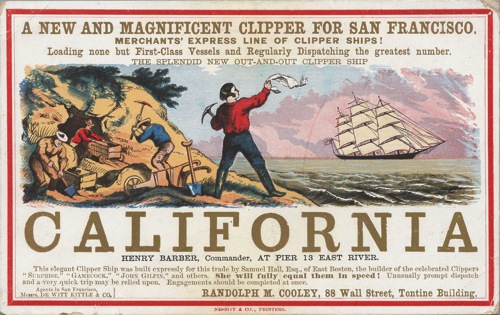The Least Resistance to New Ideas

Many years ago the San Francisco Chronicle published a short column in which the writer mentioned that he had been traveling in India, and when he told the clerk at his hotel in New Delhi that he was from the San Francisco Bay Area the clerk responded, “Oh that is the center of the universe” Um, mumbled the traveller, and why do you say that? “Because the center of the universe is wherever there is the least resistance to new ideas.”
I have not been able to come up with a better description of San Francisco’s special relation to futurism. In my experience this is true: more new ideas per person bubble up in the Bay Area than anywhere else on Earth — at this moment.
But why? The best explanation I’ve heard is from the best historian of California, J. S. Holliday, who argues that it began in the gold rush days, when hundreds of thousands of young men came stampeding into the Bay Area to start their fortunes. It was the gold.com era. There was no adult supervision. No one to tell you No. You just headed into the hills with your wits and either came back rich or poor. And if you came back poor, you sold shovel and jeans to the next wave of dreamers, and got rich in a new novel way. The Bay Area collected these young free spirits and retained them. As Holliday points out, no where else in the world was gold territory left to individuals and not the state. In part this was a matter of the great distance from Washington, which made control impossible.
Others argue the same distance from Washington and the establishment of the East Coast is what caused Stanford professors to turn to entreprenurial investments instead of grant money and corporate buyouts to go into business. That spirit of self-funding would avalanche into the start-up culture that now infuses the place. Mistakes are not only tolerated, unlike in Old Places, but even these days, mistakes are embraced as the best teacher. Bay Area VCs are more likely to give you money if you’ve already made a few disasters yourself.
John Markoff, the venerable New York Times tech reporter who also grew up in Silicon Valley, wrote an under-appreciated book called What the Doormouse Said, tracing the hippy origins of the current digital industry. Not just Steve Jobs, but many of the earliest personal computer pioneers were acid-dropping dreamers who were trying to augment human potential rather than create a new industry. They were the most recent incarnation of free thinkers that began with the 49ers, then the beatniks, and later the hippies, and now the hipsters. It is not hard to see the connection between free love and communes with open-source software and wikipedia. That’s why I agree with the urban sociologist’s Richard Florida’s notion that bohemians = innovation = wealth, and that any city or region that wants to encourage innovative wealth creation has to encourage bohemians. That’s what San Francisco has inadvertently done by the acre.
All this looseness leads to the “least resistance to new ideas” and the role of being the pivot of the world. I know this directly. Wired magazine could not have started anywhere else except in the Bay Area. When Conde Nast bought Wired they were wise enough to let it stay in SF, the only magazine they own not operated in NYC.
While the Bay Area is currently the center of the future, I sometimes have the feeling the center will slowly drift to Shanghai and other parts of China. In many ways the future is no longer so fashionable in the US. It is harder and harder to imagine a future — either via Hollywood, or business scenarios — that anyone wants to live in. All the futures are broken. Even the most techy and utopian futures are suspect and not believed. We’ve been burned too many times and know that all those inventions will bite us back. China does not have that problem and the acceleration of their desires into the future is palpable.
Of course China is still learning how to embrace its inner bohemian, and so I suspect the Bay Area will remain the center of the universe for at least a few more decades. It is one of those auto-catalytic things that feeds off itself. The more success it gains, the more newcomers with talent and ambition it attracts. In this way, success exhibits network effects, which makes it difficult to reproduce a “silicon valley” elsewhere. There will probably be only one “center of the universe” per universe at a time. (But there will be more universes!)
But this auto-catalyzing process needs to be managed. Success kills it. This is the curse of bohemian way: how do you maintain the loose reins, the cheap rents, the no-rules opportunities, when you are also creating one thousand under-30 millionaires every year? The one sure thing limiting the success of the least resistant place in the world is its success. Eventually no one can afford to make mistakes anymore, and then the center moves. You get to remain in the future by keeping loose, letting the young drive, staying hungry and foolish, ignoring success, embracing new mistakes, and having the least resistance to new ideas.


